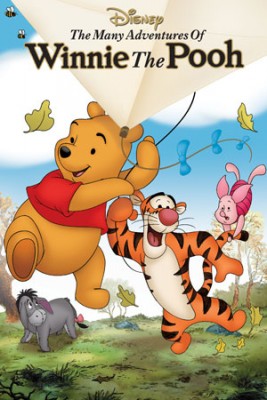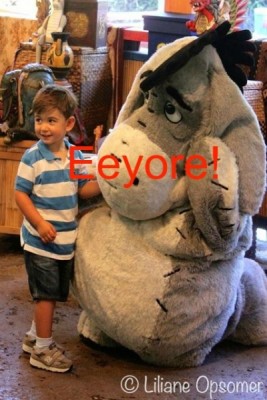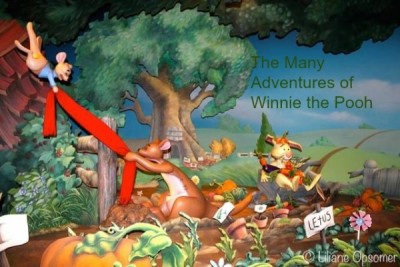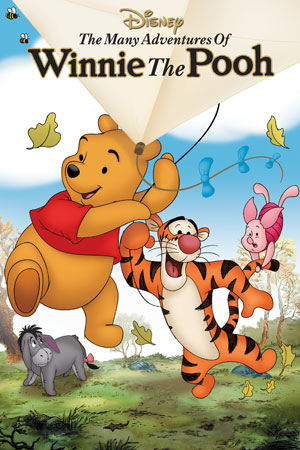
The Many Adventures of Winnie the Pooh was theatrically released as the twenty-second full-length animated feature in Disney history on March 11, 1977. The movie is based on A.A. Milne’s Winnie-the-Pooh books and is seventy-four minutes in length.
Back to the 40s
The Many Adventures of Winnie the Pooh was the first “package film” released by Disney since 1949, when The Adventures of Ichabod and Mr. Toad culminated a string of six consecutive “package” releases by Disney. The “package films” featured multiple short segments based around a common theme, in this case Winnie the Pooh, as opposed to a single plot-based story.
Disney has not released a “package film” as a full-length animated movie since The Many Adventures of Winnie the Pooh.
Plot Summary
Four short segments, three of which were previously released, compose The Many Adventures of Winnie the Pooh: “Winnie the Pooh and the Honey Tree” (1966), “Winnie the Pooh and the Blustery Day” (1968), “Winnie the Pooh and Tigger Too” (1974), and a closing short. The first three of these segments had been shown in theatres prior to Disney’s The Ugly Dachshund (1966) [see note 1 below], The Horse in the Gray Flannel Suit (1968) [see note 2 below], and The Island at the Top of the World (1974) [see note 3 below], respectively.
The Many Adventures of Winnie the Pooh occurs within a book inside the live-action bedroom of Christopher Robin. The adventures of Pooh, Piglet, Tigger, Eeyore, Rabbit, Roo, Owl, and other creatures of the Hundred Acre Wood are facilitated by a narrator.

Identity
“Everyone is special in his or her own way.” This idea may be a cliché, but it is true, and it is a major theme of The Many Adventures of Winnie the Pooh.
The flick incorporates characters with diverse personalities. Pooh is an optimist, Eeyore is a pessimist, Tigger is hyper, Rabbit is irritable, and Piglet is excitable. These differences paradoxically create harmony within the Hundred Acre Wood. Sure, Tigger’s boisterousness, to provide one example, can sometimes be annoying, but he is just being himself. The other characters possess their own flaws, which are offset by the characteristics of their counterparts.
Forcing someone to change his or her personality can prove disastrous, as Rabbit and Piglet learn with Tigger. If you find yourself in Tigger’s situation, it is a good, albeit difficult, idea to ignore what others think of you and just be yourself. If others do not appreciate you for who you are, they are not really your friends anyway. Pooh subscribes to this idea, saying, “I am short, fat; proud of that!”
Ego
Pooh is a genuinely good guy…err, bear, but he sometimes demonstrates pomposity. Pooh intrudes into Rabbit’s house for an extravagant honey lunch in the “Honey Tree” segment, and, entranced in the grandeur of his hero party at the end of “Blustery Day,” he is disappointed that the next segment in the film will highlight Tigger rather than himself. Come on, Pooh, share the love!
That’s Just Fluff!
Pooh’s generic excuse for not listening to someone is that he had fluff in his ear. If you look closely at page forty-one of the book during “Blustery Day,” it is written, not spoken, that Pooh tells Owl following a story about Owl’s uncle Clyde, “I listened, but I had a small piece of fluff in my ear. Could you say it again, please, Owl?”
Pooh verbally utilizes the same excuse during a speech by Rabbit in “Tigger Too.” Although Pooh is a living being, he is stuffed like a toy bear.
Music
The legendary Disney songwriting duo of Richard and Robert Sherman created an excellent soundtrack for The Many Adventures of Winnie the Pooh. The ten songs are alternately soothing, mysterious, and upbeat, and they all augment the story. (4)
My favorite song is “Winnie the Pooh,” which is used to introduce the film and its characters. I also like the voice in which Tigger says “I’m the only one!” to culminate his renditions of “The Wonderful Thing About Tiggers.”
Humor
The fourth wall between the characters and the audience is broken several times, because the players address the narrator.
The spelling throughout the Hundred Acre Wood leaves something to be desired. It is too bad that spell check was not available back in the day.
Piglet, Gopher, and even Eeyore bring a plethora of puns to the table. These jokes may not be laugh-out-loud funny, but they will likely make you grin.
Owl is a sage who possesses an advanced vocabulary, much life experience, and an assortment of stories. I get the sense that the other critters and Christopher Robin could live without the stories, though. Wake up, Pooh!…Oh, sorry Owl, please continue.
Pooh likes to ride balloons, march with his reflection, and eat excessive amounts of honey.
Rabbit offers free lunches against his will and satisfactorily decorates even the dirtiest areas in his house.
Tigger is scared of his own reflection and seems to like everything the best…until he doesn’t. Eww, on second thought but first taste, keep that honey for yourself, Pooh!
Animation
The animation quality is the only significant detriment to the film in my opinion. The backgrounds are largely void of detail and bring little to the table.
Relationship to Other Disney Films
In 2011, Winnie the Pooh was released as Disney’s fifty-first full-length animated feature. Additionally, DisneyToon Studios, Disney’s secondary animation division, developed Pooh’s Grand Adventure: The Search for Christopher Robin (1997), Seasons of Giving (1999), The Tigger Movie (2000), A Very Merry Pooh Year (2002), Piglet’s Big Movie (2003), Springtime with Roo (2004), Pooh’s Heffalump Movie (2005), and Pooh’s Heffalump Halloween Movie (2005).
The mysterious music and abstract images that pervade the dream sequence in “Blustery Day” reminded me of the “Pink Elephants on Parade” scene in Dumbo (1940).
Pooh was voiced by Sterling Holloway, one of the most distinctive voice actors in Disney history. Holloway narrated such shorts as “Susie the Little Blue Coupe (1952)” and “Lambert the Sheepish Lion (1952).” He also voiced the Stork in Dumbo (1941), Cheshire Cat in Alice in Wonderland (1951), Kaa the snake in The Jungle Book (1967), and Roquefort the Mouse in The Aristocats (1970).
John Fiedler, the voice of Piglet, played the old man who Kronk threw out the window in The Emperor’s New Groove (2000).
In the Parks
The Many Adventures of Winnie the Pooh is the namesake of an attraction at Walt Disney World’s Magic Kingdom, and the Disneyland Parks in California and Hong Kong, respectively. On each of these attractions, whimsical vehicles transport guests through settings themed after the movie.

The Pooh attraction at Tokyo Disneyland, “Pooh’s Honey Hunt,” also transports guests through Pooh-themed settings but utilizes a more sophisticated trackless ride system.
Do you want to dine with Pooh characters? Well, you can at Walt Disney World! Pooh, Tigger, Eeyore, and Piglet appear for breakfast, lunch, and dinner, all buffet style, at the Magic Kingdom’s Crystal Palace restaurant. Additionally, Pooh and Tigger regularly appear among Mary Poppins, Alice, and The Mad Hatter for a buffet breakfast at the Grand Floridian Resort’s “1900 Park Fare” restaurant. Advanced Dining Reservations (ADRs) are strongly recommended for all of these experiences.
Finally, for those who wish to meet Winnie the Pooh characters in a non-restaurant setting at Walt Disney World, Pooh and Tigger greet guests throughout the day at Epcot’s United Kingdom pavilion. They also usually appear outside of The Many Adventures of Winnie The Pooh attraction in Fantasyland at the Magic Kingdom.
Overall
The Many Adventures of Winnie the Pooh is an excellent film aside from the animation quality. Although the segments are not directly connected to each other, the shorts are well paced and feature interesting plots in addition to great humor and music.
Notes
1) Thompson, H. (1966, April 7). A Disney Package: Don’t Miss the Short. New York Times. Retrieved February 26, 2015, from http://0-search.proquest.com.alpha1.suffolk.lib.ny.us/docview/117083339?accountid=35174.
2) Gelmis, J. (1968, December 23). The ‘Sea Gull’ Exquisite and Brilliant. Newsday. Retrieved February 26, 2015, from http://0-search.proquest.com.alpha1.suffolk.lib.ny.us/docview/915775349?accountid=35174.
3) Levine, M. (1974, December 23). MOVIES: Stylish odyssey. Newsday. Retrieved February 26, 2015, from http://0-search.proquest.com.alpha1.suffolk.lib.ny.us/docview/920553369?accountid=35174.
4) The Many Adventures of Winnie the Pooh (1977): Soundtracks. (n.d.). Retrieved February 27, 2015, from http://www.imdb.com/title/tt0076363/soundtrack.
What do you think of The Many Adventures of Winnie the Pooh? Let me know in the comments!
Sponsored Ad: Would you like to help support The Mouse For Less website in continuing their mission of being THE Disney vacation planning resource? You can do so by purchasing The Many Adventures of Winnie the Pooh from our Affiliate Link through Amazon. Thanks so much for your support!
Incoming search terms:
- https://www themouseforless com/blog_world/movie-review-many-adventures-winnie-pooh/

